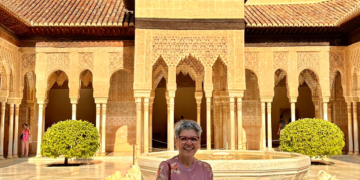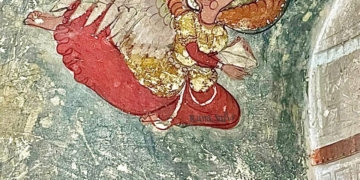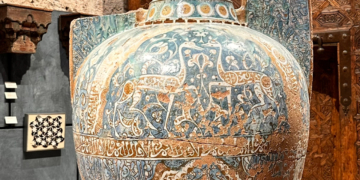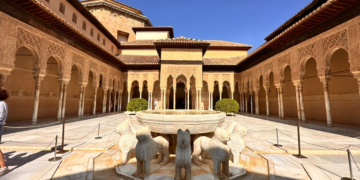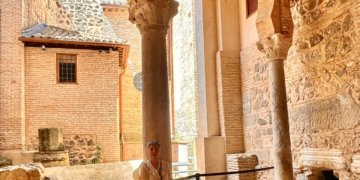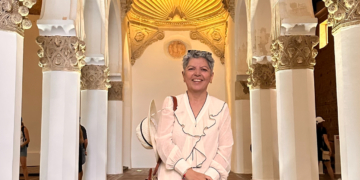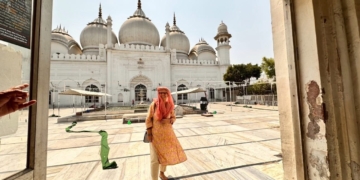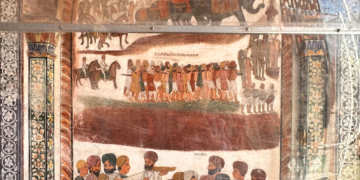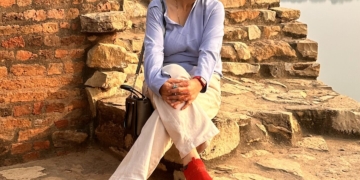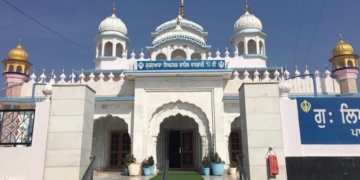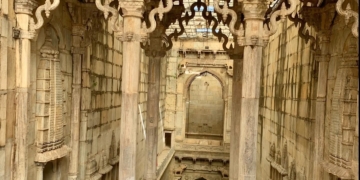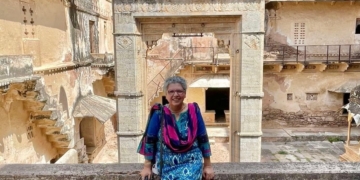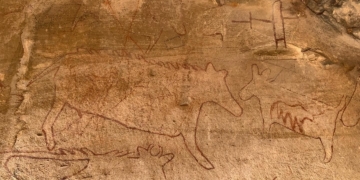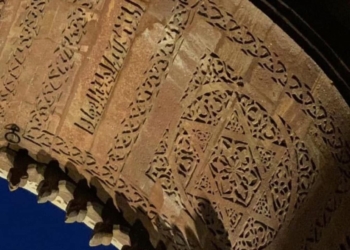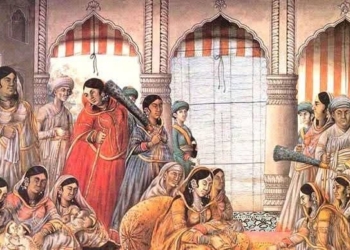After the foundation stone of the Red Fort was laid in 1639 AD, it took nine years to build the octagonal flower with its attractive buildings, refreshing gardens and streams.
On 18 April 1648 AD, it was ready to welcome Emperor Shah Jahan. He entered the Fort in an open sedan chair from the riverside. In a twist of irony, Bahadur Shah Zafar, the last Mughal Emperor, used the same Water gate to exit the fort on the night of 17 September 1857.
The Qila-e-Shahjahanabadi, or Qila-e-Mubarak (The Auspicious Fort), as the Red Fort was known then, was a piece of astounding beauty and architectural perfection and at its centre was the Diwan-e-Khas (Hall of Special Audience).
James Fergusson, the historian who worked on Indian and Eastern Architecture, has described it as “if not the most beautiful, certainly the most highly ornamented of Shahjahan’s buildings”.
‘The most beautiful building in India’
The beautiful rectangular pavilion, made of marble from top to bottom, had no rival anywhere on earth. The marble was so pure that the whiteness of dawn would seem darker than the darkest night. Its pillars and walls were decorated with gold paintings and inlaid work of precious stones such as cornelian, corals.

Shah Jahan entered the Fort with prince Dara Shukoh sprinkling gold and silver coins over his head and there were grand celebrations.
The hall was used for the reception of ministers, noblemen and ambassadors.
In the middle stood the Takht-e-Murassa (Jewelled Throne) or as it later became famous, Takht-e-Taoos (Peacock Throne).
Shah Jahan had named the hall Shah Mahal (Royal Palace), but since this was the hall of private audience for special courtiers and guests of state, it became famous as Diwan-e-Khas.
At its zenith, this was the most beautiful building in India, but now lies neglected. I invite you to close your eyes and think of it at its prime when above the end arches on both the short sides of the central aisle, the calligraphers had inscribed
Gar bar ru ye firdaus zameen ast
Hameen ast, hameen ast, hameen ast
If there is a heaven on earth
It is this, it is this, it is this!
Through its centre ran the four-yard wide Nahr-e-Bahist or stream of paradise, which was covered with marble slabs. Today the marble is yellowed, the inlaid stones have been gouged out and just a few fading flowers remain on the pillars. The stream runs dry, the only water that flows comes from the tears of the royal ghosts.
In City of My Heart, my new book, there are descriptions of the court held here and the festivities and functions in which the emperor and princes and important nobles participated. There is a description of Diwan-e-Khas during the Phool Waalon ki Sair that says, “The Diwan-e-Khas is decorated with carpets and chandeliers like a bride.”
But this bride went through many ups and downs in life. If this Diwan-e-Khas could speak, it would have so many tales to tell.
Triumphs and trials
Its best days were under Shah Jahan, when court would be held to deal with crucial matters of state.
There was an atmosphere of awe and intimidation when the emperor entered the khas darbar and whoever entered quaked in fear, in case they did something wrong.
Those present would give their salutations—Jahanpanah Badshah Salamat (Refuge of the world, may God keep the emperor safe)—by bending low from the waist and raising their hand to their forehead in salute after entering the darbar.
The Royal Gaze would go over the royal princes and they were rewarded.

The last Mughal emperor was just a nominal head and Bahadur Shah II, an accomplished poet with Zafar as his pen name would recite his latest ghazals over here.
If only it could speak, it would describe the scene here in 1716, when the Scottish surgeon William Hamilton, who cured Emperor Farrukhsiyar on the eve of his marriage, was rewarded with the permission of his employers to establish a factory and to maintain a territory of 38 villages on the banks of the Hooghly River. It was this that began the East India Company’s fortunes in India, and ultimately led to the end of the Mughal empire.

It was here that Nadir Shah the Persian invader received the submission of emperor Mohammad Shah and took the Kohinoor diamond in 1739. He also took away the Peacock Throne and the later Mughal rulers used a pale replica of it.
In the 18th century, when they were in control of Delhi, the Marathas took out all the silver and gold from the ceiling and sent it to be melted and made into coins. At that time, it was valued at Rs 28 lakh.
In 1788, Ghulam Qadir, the Rohila, captured the Mughal emperor Shah Alam II (r.1759-1806), who had been a Maratha pensioner, and imprisoned him in the adjoining Salimgarh Fort. Ghulam Qadir ordered the emperor to be brought into the Diwan-e-Khas and asked him to give up the secret of his treasure house. The unfortunate emperor had no treasure to give up and had already told his captor that many times. The emperor dared his tormentor to do his worst. Thereupon, the Rohila threw him on the floor of the same court where courtiers would quake under the royal gaze and blinded him. The Marathas defeated and killed Ghulam Qadir and once again established their sway over the emperor.
It was here that Shah Alam II thanked Lord Lake for delivering him from the Marathas in 1803 after the latter defeated the Marathas in Patparganj.
On 14 September 1803, the British force under Lord Lake entered Delhi.
Two days later, General Lake had an interview with the poor old blind king in the Diwan-e-Khas and received high-sounding titles. Delhi came under John Company, as East India Company was known.
The last Mughal emperor
By the time Akbar Shah II (r. 1806-1837) came to power, the Diwan-e-Khas was used a storeroom for unwanted items (broken palanquins, empty boxes etc) and no darbars were held.
When the ‘sepoys’ (Indian soldiers of the East India Company) came from Meerut in 1857, and persuaded ageing Mughal emperor Bahadur Shah Zafar to lead them in their fight against the East India Company, they took out a silver throne from one of the recesses of Diwan-e-Khas. On 12 May 1857, they crowned him the Emperor of Hindustan once again.
He held daily darbars here during that period, which were attended by the important residents of Delhi and officers of the ‘mutinied troops’.
It was here that one of the sepoys addressed him as “Arre Badshah! Arre buddhe!” (O you Emperor! O you old man!).
During this period, it was often full of soldiers carrying their weapons, much to the horror of Bahadur Shah Zafar—hitherto, only royalty or nobles and courtiers had entered the Diwan-e-Khas, and that too without weapons.
On 14 September 1857, the British army breached the Kashmiri Darwaza and entered the walled city of Shahjahanabad. By 17 September the emperor had fled the fort and on 20 September, he had surrendered to Major Hodson and re-entered the fort as a prisoner.
On 27 September 1857, the British held a Thanksgiving service in the Diwan-e-Khas for the fall of Delhi into their hands.
Having taken control of the Fort, the British soldiers drank to the health of the British sovereign in the Diwan-e-Khas. They established headquarters in it, and on the morning of 21 September, a royal salute was fired to celebrate the victory.
On 27 September 1857, the British held a Thanksgiving service in the Diwan-e-Khas for the fall of Delhi into their hands.
In January 1858, the emperor was put on trial in the same hall where his ancestors had ruled on the fate others. In a trial that lasted for 40 days, he was convicted of having made war against the British, abetting rebellion, proclaiming himself the reigning sovereign of India and causing or being the accessory to the death of many Europeans. He was sentenced to exile for life and sent to Rangoon.
The Diwan-e-Khas is visited by hundreds of visitors every day, but few among them know the triumphs and tragedies it has seen.


